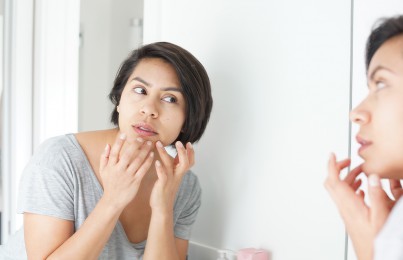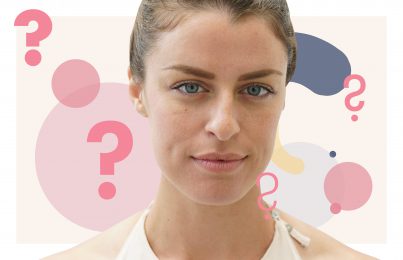Updated 8/5/18. All types of acne and blemishes are not equal. Whiteheads are a type of small blemish that comes and goes fairly quickly. In this post, I’ll first explain exactly what whiteheads are (and are not!) and then will go into how to treat them. With my expert tips, your skin can be clear and bump-free in no time.
Whiteheads are best described as infected, white bumps on the face but are not milia.
There is a lot of confusion as to what “whiteheads” really are. Whiteheads are small blemishes caused by Propionibacterium acnes (P. acnes) bacteria. They don’t have much redness or pain when touched, unlike a papule, pustule, or cyst. When they begin, the infection comes to the surface fairly quickly and forms a white-colored head. When squeezed, the pus pops out easily (usually on the first try) and not much scarring or redness is left behind. Of all the types of blemishes where the infection works its way to the surface of the skin, whiteheads are the easiest to deal with because the life cycle is fast.
It’s important to know that whiteheads that look like white bumps on the face are not milia. Milia, as you can see in the above photo is considered to be a non-inflammatory lesion. Meaning, they are like hard whiteheads on the face but aren’t actually whiteheads. Milia is often found on the upper cheeks or around the eyes and needs to be removed by a dermatologist or skilled esthetician.
Whiteheads are different from pustules.
Additionally, a lot of people get whiteheads confused with regular blemishes. In the photo above, you might think a whitehead looks a lot like a pustule. There are similarities in that they both have visible pus on the surface. However, whiteheads have less infection around them so the raised part of the face is usually just the whitehead. Versus with a pustule, you can see that not only is the whitehead protruding from the skin to make a bump but also all of the area around it, too. Simply put, a whitehead is a small bump that can be easily popped and removed (oftentimes without any blood coming along with it) and a pustule is a larger, raised bump that will be painful and when squeezed can ooze with blood.
Common causes of whiteheads:
Oily skin
Those with oily skin are going to be more likely to get whiteheads since the underlying cause of whiteheads comes from oil. (Oil breeds bacteria and bacteria leads to whiteheads.)
How to prevent whiteheads: Just like with any clogged pores, bumps, and blemishes, these all stem from having oily skin.
Exfoliating products
Sometimes if you’re new to using exfoliating acids (products with glycolic, lactic, and salicylic acids), the skin can get some whiteheads as it rearranges your skin’s cell turnover process. This can be called a “purging” process as trapped oils are being released due to the removal of surface dead skin cell buildup. Generally, this is short-lived and will go away as your skin gets used to regular exfoliation.
How to prevent whiteheads: When introducing exfoliating acids, facial scrubs, or at-home skin peels, take it slowly. If a peel says to leave it on for 10 minutes, only leave it on for two minutes. When using a facial scrub, massage it across the skin without applying much pressure so as not to aggravate the skin. If an exfoliating acid says to use it every night, start with using it just once a week. It’s all about baby steps with exfoliants until your skin gets used to them.
Hair removal such as waxing or threading
These methods of hair removal can cause the skin to purge into whiteheads so a lot of people just learn to accept it because they have no other choices for removing the hair.
How to prevent whiteheads: After removing the hair, immediately apply ice for ten minutes and then follow with a light layer of cortisone cream. This combination may help calm the inflammation that leads to whiteheads.
Moisturizer
Some moisturizers, even if it doesn’t feel particularly heavy, can have a high concentration of oils and emollients. This may block some of the pores and lead to the production of whiteheads.
How to prevent whiteheads: You always want to use a moisturizer for your skin type. (Skin types #1, #2, #3 and #4 are skin types that produce oil.) If you’re feeling tight or dry and need additional moisture, you’re better off applying a skin serum underneath to give a boost of hydration.
Liquid foundations
For some combination and oily skin types, the ingredients used in liquid foundation makeup can create a blockage in the pore-lining which leads to an infection. This can cause whiteheads to appear on the face.
How to prevent whiteheads: Switch to a powder foundation or try a different liquid foundation. A lot of times, it’s just trial and error.
Makeup primers
These “base coats” for making pores appear invisible under foundation makeup are really popular now but can act similar to liquid foundations by blocking the pores.
How to prevent whiteheads: As much as possible, try to limit their use to special occasions. Primers can contribute not only to whiteheads but also to clogged pores, bumps which lead to a bumpy texture for the skin.
Heat
Heat, such as from being outside on a hot summer day, increases sudden oil production. When the pore has too much oil trying to get through the opening, whiteheads can start up.
How to prevent whiteheads: Try to cleanse your skin as soon as possible once you get indoors to remove way any heat-induced oil. Be sure to apply toner and moisturizer afterward as you never want to leave your skin bare after cleansing. This can quickly lead to dehydration which can put your skin out of a healthy balance.
How to know if a face product is the cause of your whiteheads?
If you just started using a new product and within the first few days, you suddenly get a small cluster of 3-4 whiteheads in one area. This might be an indication that it was from something new that you applied topically. Why do whiteheads sometime appear in a certain area when you applied a new product to the entire face? More than likely, it’s because there already was some sort of blockage or disruption of oil flowing through the pore lining that erupted when something new was introduced.
How to get rid of whiteheads under the skin.
Step 1: After cleansing the skin, gently squeeze out the infection.
Once whiteheads appear on the very surface of the skin, they are very easy to pop out. Simply gently squeeze out the infection with your fingers wrapped in tissue. While some experts may cringe at the thought of me instructing people to squeeze at their faces, this can be very safe if done correctly. And in reality, no one wants to walk around with have whiteheads on their skin, right?
Step 2: After removal, apply a non-drying, antibacterial mask to disinfect the pores.
The skin will greatly benefit from using a gentle antibacterial mask that will get into the pores to ensure they stay clean. I recommend Rapid Response Detox Masque to all of my clients prone to whiteheads, clogged pores, and bumps. It uses a popular ingredient called salicylic acid which works its way into the pores lining to prevent oil blockage. Additionally, it offers other soothing benefits for calming and clearing the skin. Note: Clay masks aren’t very effective for doing this.
In summary…
Whiteheads: white bumps on the face that are not milia but rather an infected type of blemish that secretes white pus up and out through the surface of the skin. I’m often asked about how to get rid of whiteheads under the skin that appear often? A mask like Rapid Response Detox Masque can be used as often as every day to help prevent whiteheads from appearing in the first place—no matter what the cause.
Celebrity Esthetician & Skincare Expert
As an esthetician trained in cosmetic chemistry, Renée Rouleau has spent 30 years researching skin, educating her audience, and building an award-winning line of products. Her hands-on experience as an esthetician and trusted skin care expert has created a real-world solution — products that are formulated for nine different types of skin so your face will get exactly what it needs to look and feel its best. Trusted by celebrities, editors, bloggers, and skincare obsessives around the globe, her vast real-world knowledge and constant research are why Marie Claire calls her “the most passionate skin practitioner we know.”





Comments:
One of our Glycolic Serums and/or Triple Berry Smoothing Peel is your best bet. It speeds up cell turnover to prevent the dead skin cells from blocking the oil.
Posted By: Renée Rouleau |
Renee-
I started using your products recently and my skin has never looked better! I tend to get alot of milia, and I’ve had several treatments at the dermotologist to extract them. Do you have a product that will minimize them?
Posted By: Teresa Williams |
Is it in the crease of the chin? If so, that’s the way the pores form within that crease. Everyone has them but deep pore cleansing facials and home use of Glycolic Acid will help.
If it’s not necessarily in the crease, then they might be leftover old oil from previous breakouts. Again, the same advice as above.
Posted By: Lydia Noel |
I have little bumps on my chin. When I squeeze them, it’s just like squeezing a white head, although they never really come to a head. But they don’t go away! I know they’re not cysts, so what are they?
Posted By: Lexi |
Yes, we can. Depending on how close to the surface they are will depend on how easy it will be to get them out. When you call to schedule, let them know you have milia so they can schedule a little extra time for extractions.
Posted By: Lydia Noel |
Can the estheticians at RR extract milia?
Posted By: Stephanie Haynes |
It sounds like you have a clogged pore that keeps filling up with oil. Since you can get it cleaned out with squeezing it, then regular monthly deep pore cleansing facials and using a Glycolic Acid serum at home will help keep those pores cleaned.
Since it’s a large pore with a wide opening, it will probably always keep “filling up” if you don’t keep it cleaned out. Hope this helps!
Posted By: Lydia Noel |
I am hoping you can shed some light on this. I have a couple of large pores on either cheek that never form a head. Yet, ever so often, I squeeze the skin around these pores and a long thread like pus like substance comes out. What could this possibly be? Thanks!
Posted By: Nikki |
Generally speaking, cysts don’t come to a head. So it was probably a papule which turned into a pustule. But a lot of people have great luck with using our Anti Cyst Treatment for those.
Posted By: Lydia Noel |
Can a cystic pimple at some point develop a head? Which most likely means it wasn’t a cystic pimple to begin with. I ask because I have been treating what I thought was a cystic pimple for the past two weeks with the Anti-Cyst Treatment. However, instead of getting smaller, the pimple appears to be getting larger, not to mention more painful.
What do I do?
Posted By: Marcy |